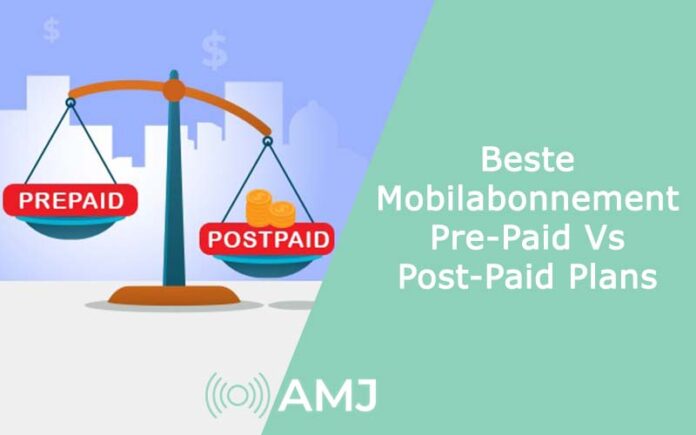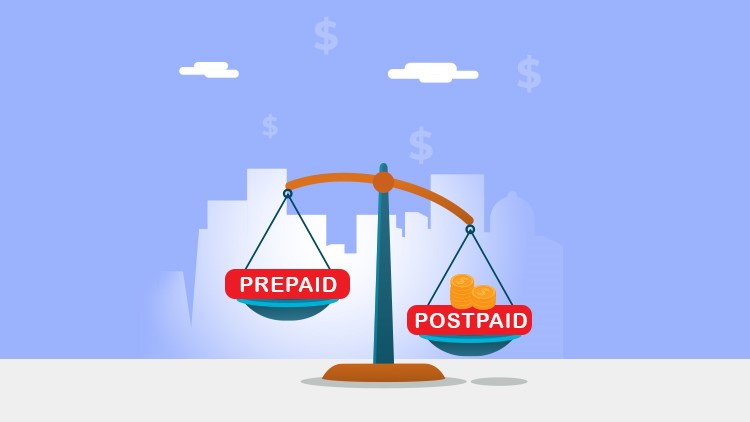
Since all of us are obsessed with our mobile phones, it’s important to know that choosing the right mobile plan can significantly impact our connectivity experience.
Two predominant options, pre-paid and post-paid plans, cater to diverse consumer needs. So, it’s a good idea to unravel the differences between pre-paid and post-paid mobile plans, so folks can make the right decision for themselves!
Contents
The Fundamental Distinction
At the core of the mobile plan dichotomy lies a fundamental difference in payment structures and usage patterns. Pre-paid plans involve paying in advance for a set amount of services, typically through recharge vouchers or online transactions.
On the other hand, post-paid plans entail users paying for services at the end of a billing cycle, based on their actual usage. You can learn more here https://medium.com/@exploreviapp/5-difference-between-prepaid-postpaid-you-should-know-about-on-vi-explore-vi-app-fc38c78a5086.
Now that we know the distinction between these two, let’s explore their pros and cons!
The Pros of Pre-Paid Plans:
Flexibility and Control
Pre-paid plans embody a sense of financial autonomy, offering users unparalleled flexibility and control over their mobile expenses. By allowing individuals to pre-determine how much they want to spend and when, pre-paid plans empower users to align their mobile usage with budget constraints or changing financial priorities.
This dynamic control ensures that users are not bound by monthly bills, granting them the freedom to manage their expenditure according to their unique circumstances.
No Credit Checks or Contracts
A distinctive advantage of pre-paid plans lies in their accessibility, eliminating the need for rigorous credit checks or lengthy contractual commitments. The absence of a binding contract allows a broader demographic, including individuals with varying credit histories, to access mobile services without the hindrance of credit-related restrictions.
This lack of contractual obligations provides users with the flexibility to discontinue services whenever they wish, aligning with their changing needs.
Cost Transparency
Transparency is a hallmark of pre-paid plans, providing users with clear and unambiguous cost structures. Users are fully aware of the exact amount they are paying for mobile services, ensuring that there are no hidden fees or surprise charges at the end of the billing cycle.
This transparency fosters an environment where users can confidently manage their budgets, as they have a precise understanding of their financial commitment to mobile services.
No Bill Shock
Pre-paid plans offer users a shield against the often-dreaded phenomenon of bill shock. With pre-paid arrangements, users can only use the services for which they have already paid, mitigating the risk of unexpected charges or overages.
This aspect not only enhances financial predictability but also instills a sense of confidence in users, as they are shielded from unwarranted financial surprises that may accompany post-paid plans.
The Cons of Pre-Paid Plans:
Limited Features and Add-ons
While pre-paid plans provide a level of cost control, they may lack certain features and add-ons that are commonly available in their post-paid counterparts.
These can include premium services such as international roaming options, bundled content subscriptions, and other value-added offerings that are often part of comprehensive post-paid packages. Users opting for pre-paid plans might miss out on these additional perks.
Inconvenience of Frequent Recharging
The convenience of pre-paid plans is counterbalanced by the need for users to frequently recharge their accounts. For individuals with high usage or those who prefer uninterrupted service, the requirement for proactive management of account balances can be perceived as inconvenient.
This constant need for recharging can be a trade-off for the flexibility and autonomy that pre-paid plans provide.
Higher Per-Minute or Per-Text Costs
While pre-paid plans offer financial control, they may come with higher per-minute or per-text costs compared to post-paid alternatives.
Although users have the advantage of controlling overall expenditure, the cost per unit of service may be less economical in certain cases. This trade-off between control and unit costs requires users to weigh their priorities and usage patterns.
Limited Access to High-End Devices
Pre-paid plans may limit access to attractive financing options for high-end devices that are often available with post-paid plans.
Users who opt for pre-paid services might find themselves needing to purchase devices outright, which can be a potential drawback for individuals seeking cost-effective ways to acquire the latest smartphones without a significant upfront payment.
The Pros of Post-paid Plans:
Extensive Features and Add-ons
Post-paid plans are synonymous with an expansive array of features and add-ons. These plans often bundle premium services, such as international roaming, family plans, unlimited data options, and content subscriptions.
The comprehensive nature of post-paid packages provides users with a holistic and convenient solution, offering a one-stop-shop for various services that cater to diverse communication needs. Find out more here.
Device Financing Options
A compelling advantage of post-paid plans is the attractive device financing options they offer. Users can acquire high-end smartphones with manageable monthly payments, spreading the cost over the duration of their contractual commitment.
This flexibility in device financing makes it more feasible for users who prefer not to make a significant upfront payment for the latest devices, presenting a clear advantage over the outright purchase model of pre-paid plans.
Convenience of Automatic Payments
The seamless nature of post-paid plans extends to the convenience of automatic payments. Operating on a monthly billing cycle, post-paid plans deduct payments automatically, eliminating the need for users to actively manage their account balances.
This hands-free approach enhances the convenience of post-paid plans, allowing users to enjoy uninterrupted services without the recurring need to recharge or top-up their accounts.
Family plans, a prominent feature in many post-paid offerings, present a distinct advantage for users with multiple lines. Post-paid family plans allow users to share a pool of minutes, texts, and data across multiple lines, streamlining billing and promoting cost efficiency.
This shared structure ensures that families or groups with multiple users can manage their communication expenses in a cohesive and economically advantageous manner.
The Cons of Post-paid Plans:
Credit Checks and Contracts
The accessibility of post-paid plans is often contingent upon credit checks and contractual commitments. Users considering post-paid services may need to undergo credit assessments, and the requirement for a long-term contract, typically spanning 12 to 24 months, can be perceived as a drawback.
These contractual obligations may limit flexibility for individuals with limited credit history or those seeking shorter-term commitments.
Potential for Bill Shock
Post-paid plans carry an inherent risk of bill shock, especially if users surpass the allocated limits for minutes, texts, or data.
Additional charges for exceeding these limits can result in unexpectedly high bills at the end of the billing cycle. This unpredictability may pose a challenge for users seeking a more predictable and controlled financial commitment, as the final bill is contingent upon actual usage.
Less Control Over Spending
While post-paid plans offer convenience and an extensive array of services, they may limit users’ control over monthly spending.
The predetermined nature of these plans may not align perfectly with users’ variable usage patterns, potentially resulting in users paying for services they do not fully utilize. This trade-off between convenience and financial control is a crucial consideration for individuals who prioritize autonomy over bundled services.
Early Termination Fees
Breaking a post-paid contract before its term completion often incurs early termination fees. This financial penalty can be a deterrent for users who need to change plans or carriers before the contract expires.
The imposition of early termination fees adds an additional layer of financial commitment that users must consider when opting for post-paid plans.
How to Choose?
Choosing between a pre-paid and a post-paid mobilabonnement is a decision that hinges on several key factors, each influencing the overall mobile experience. Here’s what you need to do:
Assess Your Financial Preferences
Begin by assessing your financial preferences and how you prefer to manage your expenses. If you value control over your budget, appreciate the ability to set a predetermined spending limit, and seek the flexibility to adjust your usage in real-time, a pre-paid plan may align better with your financial philosophy.
On the other hand, if you are comfortable with a monthly billing cycle, automatic deductions, and the convenience of a continuous service flow without the need for frequent recharges, a post-paid plan may be more suitable.
Evaluate Your Communication Patterns
A prepaid plan gives you the freedom to adjust your consumption to your needs, which is great if your usage is unpredictable and you like to have control over your cell service expenses.
Alternatively, if you are a heavy mobile user, regularly make calls, send texts, and use data-intensive applications, a post-paid plan with its bundled services and potentially lower per-unit costs may offer more value for your communication needs.
Factor in Device Financing Preferences
If you prefer the flexibility of purchasing devices outright and having the freedom to switch between devices without contractual commitments, a pre-paid plan complements this approach.
Conversely, if you enjoy the convenience of device financing options, where you can acquire high-end smartphones with manageable monthly payments, a post-paid plan often provides more attractive financing deals.
Analyze Your Credit Situation
Pre-paid plans are generally accessible without the need for credit checks, making them an inclusive option for individuals with varying credit histories.
If you have a strong credit history and are comfortable undergoing credit assessments, post-paid plans offer additional perks such as family plans, device financing, and bundled services.
Consider Long-Term Commitments
Lastly, you should evaluate your stance on long-term commitments. Pre-paid plans are typically contract-free, allowing you the freedom to switch carriers or plans without any contractual obligations. If you value this flexibility and prefer the option to change plans or carriers without penalties, a pre-paid plan aligns with this preference.
Conversely, if you are comfortable with committing to a specific carrier and plan for a more extended period, a post-paid plan may offer additional benefits and features with a longer-term commitment.














![Index of Money Heist [Season 1, 2, 3 & 4 – All Episodes, Cast and Plot] Index of Money Heist](https://www.asiamediajournal.com/wp-content/uploads/2021/05/Index-of-Money-Heist-3-100x70.jpg)